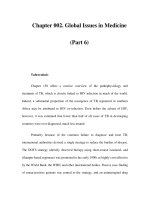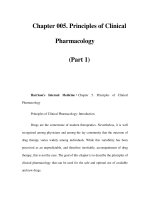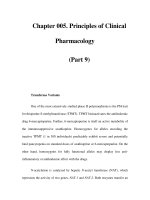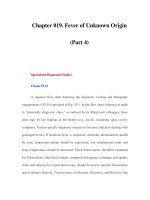Chapter 095. Carcinoma of Unknown Primary (Part 6) pps
Bạn đang xem bản rút gọn của tài liệu. Xem và tải ngay bản đầy đủ của tài liệu tại đây (13.28 KB, 6 trang )
Chapter 095. Carcinoma of
Unknown Primary
(Part 6)
Management of Disseminated CUP
Patients who present with liver, brain, and adrenal metastatic disease
usually have a poor prognosis. Beside primary peritoneal carcinoma,
carcinomatosis presenting as CUP in other settings is not uncommon. Gastric,
appendicular, colon, pancreas, and cholangiocarcinoma are all possible primaries,
and imaging, endoscopy, and pathologic data help in the evaluation.
Traditionally, platinum-based combination chemotherapy regimens have
been used to treat patients with CUP. In a phase II study by Hainsworth and
colleagues, 55 mostly chemotherapy-naive patients were treated with paclitaxel,
carboplatin, and oral etoposide every 3 weeks. The overall response rate was 47%,
with median overall survival duration of 13.4 months. Briasoulis and colleagues
reported similar response rates and survival durations in 77 patients with CUP who
had been treated with paclitaxel and carboplatin. In this study, patients with nodal
or pleural disease and women with peritoneal carcinomatosis had higher response
rates and overall survival durations of 13 and 15 months, respectively. Studies
incorporating newer agents, including gemcitabine, irinotecan, and targeted
agents, are showing higher response rates. In a phase II randomized trial by Culine
and colleagues, 80 patients were randomly assigned to receive gemcitabine with
cisplatin or irinotecan with cisplatin; 78 patients were assessible for efficacy and
toxicity. Objective responses were observed in 21 patients (55%) in the
gemcitabine and cisplatin arm and in 15 patients (38%) in the irinotecan and
cisplatin arm. The median survival was 8 months for gemcitabine and cisplatin
and 6 months for irinotecan and cisplatin.
The role of second-line chemotherapy in CUP is poorly defined.
Gemcitabine as a single agent has shown a partial response rate of 8%, and 25% of
patients had minor responses or stable disease, with improved symptoms.
Combination chemotherapy as a second- and third-line treatment may result in a
slightly improved response.
Combination targeted therapy is being evaluated. Hainsworth and
colleagues studied the combination of bevacizumab and erlotinib in 51 patients;
25% were chemotherapy-naive and had advanced bone or liver metastases, while
the rest had been previously treated with 1 or 2 chemotherapy regimens.
Responses were noted in 4 patients (8%), and 30 patients (59%) experienced
stable disease or a minor response. The median overall survival was 8.9 months,
with 42% of patients alive at 1 year.
Historically, patients with CUP have been treated with "global" regimens
that work for a variety of primary cancers. With incremental improved responses
over the past decade in known cancer types, we anticipate overall better response
rates with newer regimens for selected CUP patients. With a more robust
immunohistochemical panel (directed approach) and new molecular data, one may
be able to create a more tailored algorithm for CUP patients.
Summary
Patients with CUP should undergo a directed diagnostic search for the
primary tumor on the basis of clinical and pathologic data. Subsets of patients
have prognostically favorable disease, as defined by clinical or histologic criteria,
and may substantially benefit from aggressive treatment and expect prolonged
survival. However, for most patients who present with advanced CUP, the
prognosis remains poor, with early resistance to available cytotoxic therapy.
Research into the metastatic phenotype will help us improve our understanding of
CUP tumor biology. Whether the CUP clone is a distinct molecular genotype-
phenotype that is different from metastases of known primary tumors remains to
be elucidated. The identification of specific CUP-related molecular and
biochemical targets may help exploit therapeutic targeted agents for this entity.
Further Readings
Abbruzzese JL et al: The biology of unknown primary tumors. Semin
Oncol 20:238, 1993 [PMID: 8503019]
Bugat R
et al: Summary of the standards, options and recommendations for
the management of patient
s with carcinoma of unknown primary site. Br J Cancer
89(Suppl 1):S59, 2003
Culine S et al: Cisplatin in combination with either gemcitabine or
irinotecan in carcinomas of unknown primary site: Results of a randomized phase
II study—trial for the French
Study Group on Carcinomas of Unknown Primary
(GEFCAPI 01). J Clin Oncol 21:3479, 2003 [PMID: 12972523]
Dennis JL, Oien KA: Hunting the primary: novel strategies for defining the
origin of tumours. J Pathol 205:236, 2005 [PMID: 15641019]
Greco FA, Hainsworth JD: One-hour paclitaxel, carboplatin, and extended-
schedule etoposide in the treatment of carcinoma of unknown primary site. Semin
Oncol 24(6 Suppl 19):S19, 1997
Kende AI et al: Expression of cytokeratins 7 and 20 in carcinomas of the
gastrointestinal tract. Histopathology 42:137, 2003 [PMID: 12558745]
Lobins R, Floyd J: Small cell carcinoma of unknown primary. Semin Oncol
34:39, 2007. [PMID: 17270664]
Olson JA Jr et al: Magnetic resonance imaging facilitates breast
conservation for occult breas
t cancer. Ann Surg Oncol 7:411, 2000 [PMID:
10894136]
Rusthoven KE et al: The role of fluorodeoxyglucose positron emission
tomography in cervical lymph node metastases from an unknown primary tumor.
Cancer 101:2641, 2004 [PMID: 15517576]
Varadhachary G
R et al: Diagnostic strategies for unknown primary cancer.
Cancer 100:1776, 2004 [PMID: 15112256]
Bibliography
Roh MS, Hong SH: Utility of thyroid transcription factor-
1 and cytokeratin
20 in identifying the origin of metastatic carcinomas of cervical ly
mph nodes. J
Korean Med Sci 17:512, 2002 [PMID: 12172048]









